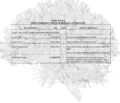Difference between revisions of "2016 Summer Project Week/DICOM Tractography Results"
From NAMIC Wiki
(Created page with "__NOTOC__ <gallery> Image:PW-Summer2016.png|Projects List </gallery> ==Key Investigators== * Michael Onken * Isaiah Norton * Lauren O'Do...") |
|||
| (3 intermediate revisions by 2 users not shown) | |||
| Line 2: | Line 2: | ||
<gallery> | <gallery> | ||
Image:PW-Summer2016.png|[[2016_Summer_Project_Week#Projects|Projects List]] | Image:PW-Summer2016.png|[[2016_Summer_Project_Week#Projects|Projects List]] | ||
| + | Image:DICOM_tracto.png | ||
</gallery> | </gallery> | ||
==Key Investigators== | ==Key Investigators== | ||
* Michael Onken | * Michael Onken | ||
| − | * Isaiah Norton | + | * Isaiah Norton (remotely) |
* Lauren O'Donnell | * Lauren O'Donnell | ||
| Line 18: | Line 19: | ||
* Add API to DCMTK (library called dcmtract) which allows easy creation and reading of DICOM Tractography Results objects | * Add API to DCMTK (library called dcmtract) which allows easy creation and reading of DICOM Tractography Results objects | ||
* Tractography Results objects have been introduced in DICOM with [ftp://medical.nema.org/medical/dicom/final/sup181_ft_TractographyResultsStorage.pdf Supplement 181] in 2015. | * Tractography Results objects have been introduced in DICOM with [ftp://medical.nema.org/medical/dicom/final/sup181_ft_TractographyResultsStorage.pdf Supplement 181] in 2015. | ||
| − | * From the Supplement: Tractography results are usually calculated based on magnetic resonance diffusion tractography (MR DT). A tracking algorithm produces tracks (i.e. fibers), | + | * From the Supplement: Tractography results are usually calculated based on magnetic resonance diffusion tractography (MR DT). A tracking algorithm produces tracks (i.e. fibers), which are collected into track sets. A track contains the set of x, y and z coordinates of each point making up the track. Depending upon the algorithm and software used, additional quantities like Fractional Anisotropy (FA) values or color etc. may be associated with the data, by track set, track or point, either to facilitate further filtering or for clinical use. Descriptive statistics of quantities like FA may be associated with the data by track set or track. |
| − | which are collected into track sets. A track contains the set of x, y and z coordinates of each point making up the track. Depending upon the algorithm and software used, additional quantities like Fractional Anisotropy (FA) values or color etc. may be associated with the data, by track set, track or point, either to facilitate further filtering or for clinical use. Descriptive statistics of quantities like FA may be associated with the data by track set or track. | ||
* This week we will work to discuss and finalize the API of the the library and prepare it for checkin to DCMTK | * This week we will work to discuss and finalize the API of the the library and prepare it for checkin to DCMTK | ||
</div> | </div> | ||
| Line 25: | Line 25: | ||
<h3>Approach, Plan</h3> | <h3>Approach, Plan</h3> | ||
* Discuss existing API and refine it if required | * Discuss existing API and refine it if required | ||
| + | * Discuss naming consistency (track vs tract) | ||
| + | * Discuss how to handle features currently missing from the standard but supported in Slicer (should we prepare a list of conventions to be the basis for a future DICOM change proposal). | ||
</div> | </div> | ||
<div style="width: 27%; float: left; padding-right: 3%;"> | <div style="width: 27%; float: left; padding-right: 3%;"> | ||
<h3>Progress</h3> | <h3>Progress</h3> | ||
* There is already a version of the dcmtract library in DCMTK | * There is already a version of the dcmtract library in DCMTK | ||
| + | * Productive conversations about coordinate systems, plan for DICOM in Slicer, release next week of DICOM tracts on SlicerDMRI site | ||
</div> | </div> | ||
</div> | </div> | ||
Latest revision as of 09:53, 25 June 2016
Home < 2016 Summer Project Week < DICOM Tractography ResultsKey Investigators
- Michael Onken
- Isaiah Norton (remotely)
- Lauren O'Donnell
Project Description
This software project deals with saving tractography data in DICOM.
Objective
- Add API to DCMTK (library called dcmtract) which allows easy creation and reading of DICOM Tractography Results objects
- Tractography Results objects have been introduced in DICOM with Supplement 181 in 2015.
- From the Supplement: Tractography results are usually calculated based on magnetic resonance diffusion tractography (MR DT). A tracking algorithm produces tracks (i.e. fibers), which are collected into track sets. A track contains the set of x, y and z coordinates of each point making up the track. Depending upon the algorithm and software used, additional quantities like Fractional Anisotropy (FA) values or color etc. may be associated with the data, by track set, track or point, either to facilitate further filtering or for clinical use. Descriptive statistics of quantities like FA may be associated with the data by track set or track.
- This week we will work to discuss and finalize the API of the the library and prepare it for checkin to DCMTK
Approach, Plan
- Discuss existing API and refine it if required
- Discuss naming consistency (track vs tract)
- Discuss how to handle features currently missing from the standard but supported in Slicer (should we prepare a list of conventions to be the basis for a future DICOM change proposal).
Progress
- There is already a version of the dcmtract library in DCMTK
- Productive conversations about coordinate systems, plan for DICOM in Slicer, release next week of DICOM tracts on SlicerDMRI site

